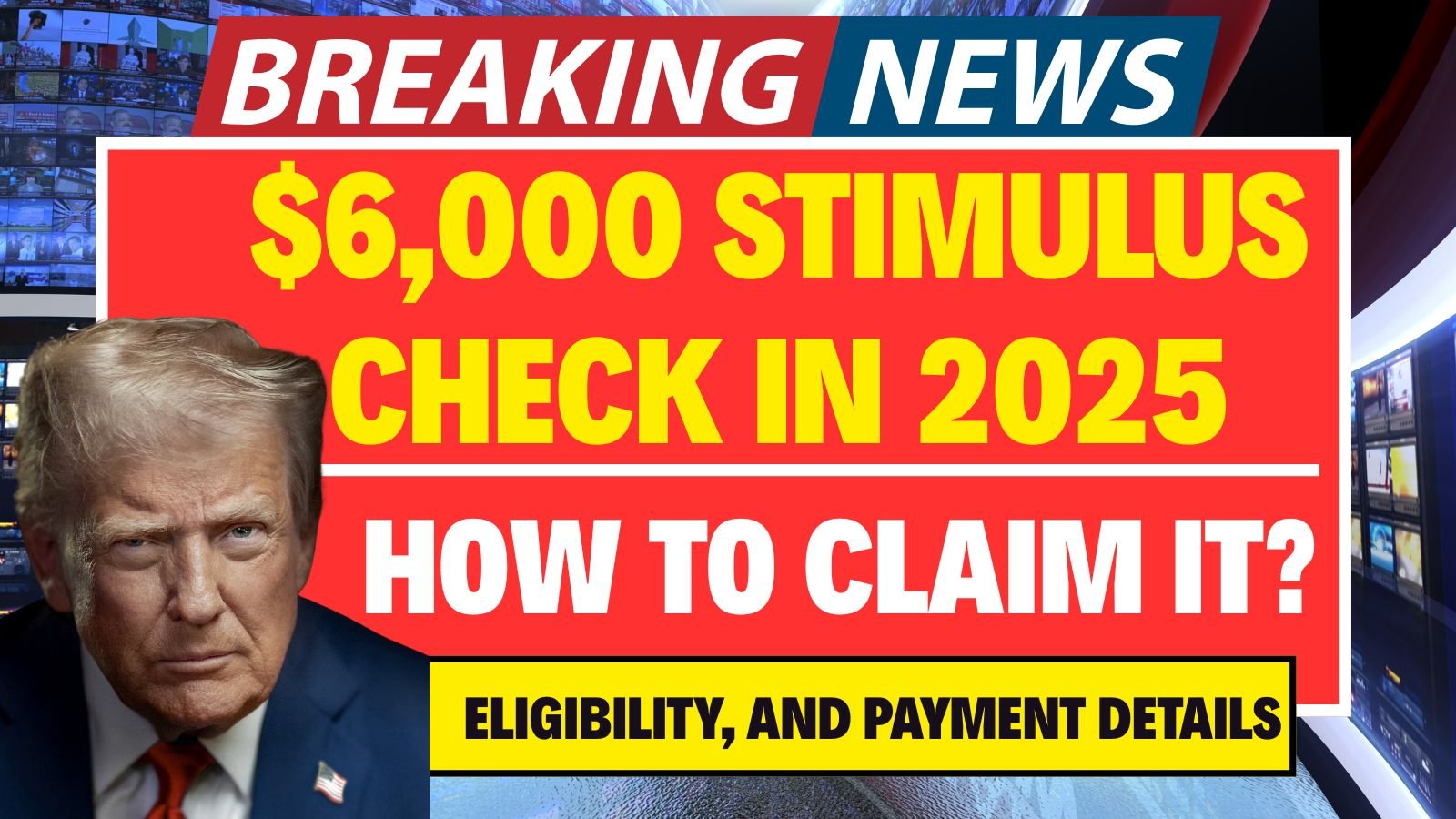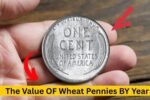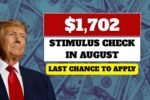In 2025, the U.S. government is preparing to roll out one of the most substantial direct cash assistance programs in recent years — the $6,000 Stimulus Check. At a time when households across the nation are grappling with the rising costs of living, persistent inflation, and uncertain job markets, this program is being hailed as a critical lifeline for millions of Americans.
While smaller stimulus payments in past years have helped many meet urgent needs, this initiative stands out for its larger payout, broader coverage, and relatively straightforward eligibility process. For families, the stakes are even higher — a household of four could potentially receive up to $24,000, depending on qualifying conditions.
This article will break down every aspect of the $6,000 Stimulus Check, including eligibility rules, payment timelines, how the funds will be distributed, and how this payment might interact with other benefits you already receive.
$1,702 Stimulus Payment for Everyone – August 2025 Full Payment Schedule
Quick Summary of the $6,000 Stimulus Check Program
| Program Name | $6,000 Presidential Stimulus Payment 2025 |
|---|---|
| Managed By | Franchise Tax Board (FTB) |
| Country | USA |
| Eligibility | U.S. Citizens & Legal Residents |
| Payment Amount | $6,000 per qualified individual |
| Payment Method | Direct Deposit or Mailed Check |
| Payment Start | Within weeks after the bill is enacted |
| Official Website | ftb.ca.gov |
Why the $6,000 Stimulus Check Is a Big Deal
Economic experts agree that a $6,000 Stimulus Check is more than just a short-term boost. This one-time payment has the potential to offer meaningful relief for individuals and families trying to stabilize their finances after years of economic turbulence.
With inflation impacting everything from groceries to housing, even middle-income households are feeling the pinch. By injecting a substantial lump sum into households, the government aims to give people the ability to catch up on overdue bills, pay down debt, invest in their future, and create a small cushion for emergencies.
Eligibility Requirements for the $6,000 Stimulus Check
Not everyone will qualify for the $6,000 Stimulus Check, and understanding the eligibility criteria is key to avoiding disappointment. The program’s goal is to target support toward lower- and middle-income households while excluding high-income earners.
Here are the main conditions:
-
U.S. Citizenship or Legal Residency – You must be a U.S. citizen or legal resident with valid proof of residency.
-
Valid Social Security Number – This is required for payment processing.
-
Income Thresholds – Tentatively, individuals earning below $100,000 and couples earning below $180,000 qualify. Those in the phase-out range will see reduced payments.
-
Recent Tax Filing – You must have filed a federal tax return in 2023 or 2024, unless you are receiving certain federal benefits.
-
Qualifying Benefit Recipients – People on SSI (Supplemental Security Income), SSDI (Social Security Disability Insurance), or VA (Veterans Affairs) benefits are also eligible.
-
Updated Payment Details – Direct deposit information and mailing addresses must be accurate to ensure smooth delivery.
How the $6,000 Stimulus Check Will Be Distributed
The distribution process is designed to be automatic for most eligible individuals. If you’ve received federal payments in the past, you’ll likely be familiar with how this works:
-
Automatic Payment for Tax Filers & Benefit Recipients – If you filed taxes or receive Social Security, SSDI, SSI, or VA benefits, your payment will likely be issued automatically.
-
Direct Deposit or Mailed Check – Direct deposit is the fastest method, while paper checks or prepaid debit cards may take longer.
-
Notification Process – Many recipients will receive an official letter or secure digital message confirming the payment amount and expected delivery date.
To safeguard against fraud or payment delays, keep copies of your bank statements, IRS notices, or FTB confirmations until the payment is securely in your possession.
Potential Payment Timeline
While exact dates will depend on how quickly the legislation passes, past stimulus rollouts provide some clues. Payments could start arriving within weeks of the bill being signed into law. Direct deposits are usually processed first, with paper checks following soon after.
If Congress passes the stimulus bill in the first quarter of 2025, it’s possible that the first wave of payments could begin as early as late spring or early summer.
How You Can Use the $6,000 Stimulus Check
The beauty of the $6,000 Stimulus Check is that there are no spending restrictions — you can use the funds however you see fit. Many financial experts, however, recommend prioritizing:
-
Paying Overdue Bills – Clear any outstanding rent, utilities, or credit card debt to avoid late fees and interest charges.
-
Covering Essential Costs – Allocate funds to groceries, transportation, child care, and medical needs.
-
Investing in Education or Skills – Consider courses, certifications, or tools that can help boost future income.
-
Building an Emergency Fund – Even a few thousand dollars set aside can provide peace of mind during unexpected hardships.
Impact on Other Government Benefits
One of the most important questions people have is whether the $6,000 Stimulus Check will affect their eligibility for other benefits. Fortunately, the payment is tax-free and, in most cases, will not be counted as income for:
-
SNAP (Food Stamps)
-
Medicaid
-
Supplemental Security Income (SSI)
-
Subsidized Housing Programs
Even so, benefit recipients should confirm with their local caseworker or agency to ensure they avoid misreporting and maintain uninterrupted assistance.
Avoiding Common Mistakes
Even with an automatic payment system, mistakes can happen. Here are the biggest pitfalls to avoid:
-
Outdated Bank Information – If your account is closed or incorrect, your payment may be delayed.
-
Incorrect Mailing Address – Paper checks sent to the wrong address can take months to reissue.
-
Ignoring IRS or FTB Notices – If you receive a request for additional information, respond promptly to avoid losing your payment.
-
Assuming Ineligibility Without Checking – Even if you didn’t qualify for past stimulus programs, this one has different rules, so double-check.
Why This Stimulus Matters
The $6,000 Stimulus Check isn’t just a number on paper — it’s a potential turning point for millions of households. For individuals, it can mean clearing debt or avoiding eviction. For families, it can help ensure kids have food, a stable home, and access to essential services.
Unlike smaller payments of $1,200 or $1,400 in past relief bills, this payment offers a chance to make a meaningful financial reset.
What to Do If You Don’t Receive Your Payment
If the payment window opens and you don’t receive your $6,000 Stimulus Check within the expected timeframe:
-
Check the IRS or FTB Payment Tracker – Online portals usually provide payment status updates.
-
Contact Your Bank – Sometimes deposits are held temporarily for verification.
-
Watch Your Mail – Paper checks or prepaid debit cards may take longer to arrive.
-
Call the Official Hotline – Use the number listed on the FTB or IRS website, not unofficial sources.
Final Thoughts
The $6,000 Stimulus Check represents a bold step in direct economic support, giving eligible Americans a meaningful sum that can be used for immediate needs or future planning. Whether you’re an individual struggling to cover rent or a family trying to balance rising food and childcare costs, this payment could make 2025 a year of financial recovery instead of continued hardship.
The key to benefiting from this program is simple: stay informed, ensure your personal and banking details are correct, and be alert to official updates. For those who qualify, this is not just a check — it’s an opportunity to stabilize, rebuild, and prepare for the future.
FAQs: $6,000 Stimulus Check
Q1. Do I have to apply for the $6,000 Stimulus Check?
No. Most eligible individuals will receive the payment automatically, based on tax return information or existing benefit records.
Q2. Will the $6,000 Stimulus Check affect my food stamps or Medicaid?
No, it’s tax-free and generally excluded from income calculations for these programs, though you should confirm locally.
Q3. When will the $6,000 Stimulus Check payments start?
Payments are expected to begin within a few weeks of the bill becoming law.
Q4. What if I changed banks recently?
Update your direct deposit information with the IRS or FTB to avoid delays.
Q5. How much can a family receive?
A family of four could potentially receive up to $24,000 if all members meet eligibility criteria.
Some Important Link
| Download News APP | Click Here |
| WhatsApp Group | Click Here |
| Home Page | Click Here |





